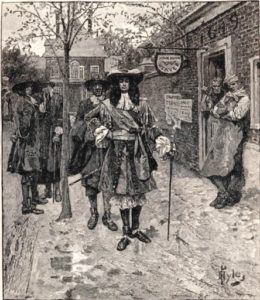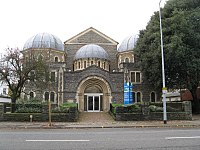Welsh - The Tudors, Religious Conflict
In Wales, a royal house descended from the Tudors of Penmynydd. During the War of Roses, Henry Tudor defeated Richard III at the battle of Bosworth and took the throne as Henry VII. The significance to Wales comes with his son, Henry VIII.
Henry VIII was born in 1491 and died in 1547. He did away with the laws of Hywel Dda, and only English law remained. All legal matters had to be done in the English language. His actions led to diminishing the Welsh language which almost ended with the Welsh language becoming extinct. The reason for the legal change, was that the Welsh counties in the border region (the Marches) were troublesome for his father Henry VII. Henry felt that putting all courts under English jurisdiction would help in governing Wales. At first the Welsh welcomed Henry VII as one of their own. He was a descendent of Glyn Dwr. After all, the Tudors were Welsh, you know! This was the real end of any chance of Welsh independence. From this point forward, Wales would be considered as a region of England, a part of the Commonwealth.
Henry VIII, broke away from the Catholic Church and formed the Church of England, a protestant church. This opened the gate to eventual nonconformist religions in Wales. This is highly significant in history, because nonconformity established the religious culture in Wales that exists to this day. The music, the pageantry, the very fabric of Welsh life is ingrained in Henry’s break with Rome.
Henry’s daughter, Elizabeth I brought Catholicism back. This pleased the Welsh who had been largely Catholic. This change was not to last. When Oliver Cromwell and parliament eliminated the king, Catholics were persecuted in Wales. The Puritan movement had begun. Eventually, this was replaced by a Calvinist Methodist movement.
The Protestant Reformation
In the 16th-century, a movement began that was the result of changes in ideas. Cultures and politics began to change. Intellectuals began to question values and religion. The religion of Europe was Roman Catholic. These intellectuals, often religious leaders such as Martin Luther, John Calvin, and John Penry started to question papal authority. Henry VIII took advantage of the movement, which allowed him to break with Rome and Pope.
This movement was not peaceful. It caused wars and persecution. In areas that still adhered to Catholicism, it even necessary to protect the Catholic clergy. In my own ancestral home in Wales, we had a Priests Hiding Hole. A hidden room where the local Priest took shelter from Cromwell’s army. The interesting fact is that my ancestor, Hugh Penry of Llangamarch, who hid the priest was the local Anglican Vicar of Devynock!
On the European continent, there was a backlash and Catholics often put Protestants to death in a period called the Counter-Reformation. The acceptance of both Catholics and Protestants coexisting took many, many years with events such as the Thirty Year’s War and the Treaty of Augsburg which allowed Lutherans and Catholics to coexist in Germany. This difference is often highly political and still exists in Ireland. The “Troubles” in Northern Ireland lasted from the 1960s until the Good Friday agreement of 1998! It was a period of murders, bombings, and riots. Even today, Catholics usually stay in their homes on Ulster Day.
This Protestant/Catholic antagonism was evident when I lived in Scotland in the 1960s. This cultural warfare even took place during football games. The stadium in Glasgow separated the fans by a barbed-wire fence. The Rangers were Protestant, the Celtic were Catholic. A popular folk song of the period had these lyrics “So don’t wear a green scarf in Brigton, or a blue scarf in Cumberland Street, unless your a heavy-weight champion or a hell of quick on your feet!”
I had a personal experience with the rivalry. I had a Celtic band in Edinburgh in the 1960’s “The Gatekeepers”. We had finished our gig and it was late, nearly midnight. I boarded a double-decker bus to home in Kirknewton, about 8 miles from Edinburgh. There had been a Ranger and Celtic football game that day in Edinburgh. The bus had about 20 Celtic fans heading toward Glasgow. They were in very “high” spirits, singing and having fun. About six miles from Kirknewton, we stopped and a group of Ranger fans came aboard. I looked at the conductress, she looked at me, and we both knew what was about to happen. We both stepped off the bus in the middle of the countryside and began walking. As the bus disappeared into the distance, we could see it swerving and rocking! About two files further down the road, we came across the bus and several Black Maria’s (police vans), hauling our rioting footballers away. We got back on the bus and continued our journey
Religion in Wales
Wales was much more liberal than England in religious tolerance. The Welsh have a history of freethinking and nonconformity.
The following is an excerpt from the Wikipedia article, Religion In Wales
Nonconformity, membership and revival
Nonconformity grew rapidly and came to dominate the religious life of Wales from the eighteenth to the twentieth centuries. The Welsh Methodist revival of the 18th century was one of the most significant religious and social movements in the history of Wales. The revival began within the Church of England in Wales and at the beginning remained as a group within it, but the Welsh revival differed from the Methodist revival in England in that its theology was Calvinist rather than Arminian. Welsh Methodists gradually built up their own networks, structures, and even meeting houses (or chapels), which led eventually to the secession of 1811 and the formal establishment of the Calvinistic Methodist Presbyterian church of Wales in 1823. Emotionalism had free rein; in contrast to Scotland with its four universities, good schools, and a strong theological tradition, Wales had no universities and widespread illiteracy.
The Welsh Methodist revival also had an influence on the older nonconformist churches, or dissenters – the Baptists and the Congregationalists – who in turn also experienced growth and renewal. As a result, by the middle of the nineteenth century, Wales was predominantly a nonconformist country.
Statistics of membership between 1680 and 1840 demonstrate that the established Church of England lost one-fifth of its membership. In addition, an ever-increasing number of nominal Anglicans also ceasing to practise. Nonconformity more than quadrupled, mainly from 1760 and especially after 1800. In 1800 there were twice as many Anglican churches as Nonconformist chapels; in 1850, chapels outnumbered churches by a ratio of 5 to 2. Roman Catholicism kept pace with demographic growth, but, even reinforced by Irish immigration, remained a limited force in 1840. Judaism and overt irreligion were both rare.
In 1910, the nonconformist bodies numbered 550,000 members, as against 193,000 in the established Church of England. Nonconformists, led by Liberal David Lloyd George, increasingly controlled the politics of Wales, although the elite sectors were still dominated by the Anglicans.
The 1904-1905 Welsh Revival was the largest full scale Christian Revival of Wales of the 20th century. At least 100,000 people became Christians during the 1904–1905 revival. Even so, it did not put a stop to the gradual decline of Christianity in Wales, only holding it back slightly.[14] Despite this, by 2011 South Wales (and especially settlements in the former coalfield area) showed the highest proportions of no religion anywhere in the country, rising in places to over 50%. The reasons for this are unclear.
Disestablishment – creation of the Church in Wales
In reaction to the rise of nonconformity, some Anglicans came to recognise the weaknesses of the established church and its failure to counteract the popular aspects of nonconformity. The rigidity of the parish system and the distance between churches were quoted as examples of the failure of the church to adapt
The Welsh Church Act 1914 provided for the separation of the four dioceses of the Church of England located in Wales (known collectively as the Church in Wales) from the rest of the Church, and for the simultaneous disestablishment of the Church. The Act came into operation in 1920. Since then there has been no established church in Wales.
Present-day Roman Catholicism
Catholics are served by the Ecclesiastical Province of Cardiff, which exists out of the Archdiocese of Cardiff, the Diocese of Menevia and the Diocese of Wrexham. The bishops of these dioceses are part of the Catholic Bishops’ Conference of England and Wales.
Sabbatarianism[edit]
The Sabbatarian temperance movement was strong among the Welsh in the Victorian period and the early twentieth century, the sale of alcohol being prohibited on Sundays in Wales by the Sunday Closing Act of 1881. This remained in parts of Wales until 1996.
Saints[edit]
A monastic community was founded by Saint David at what is now St David’s. The present building of St David’s Cathedral was started in 1181.
Saint David is the patron saint of Wales
Islam[edit]
Main article: Islam in Wales
The largest non-Christian faith in Wales is Islam, with about 46,000 adherents in 2011. Most Muslims live in Cardiff (23,656 in 2011, 6.8% of the population), but there are also significant numbers in Newport (6,859 in 2011) and Swansea (5,415 in 2011).
There has been a Somali and Yemeni Islamic community in Cardiff since the mid-1800s, founded by seafarers to Cardiff Docks
Judaism[edit]
Main article: History of the Jews in Wales
Old building of the Cardiff United Synagogue.


